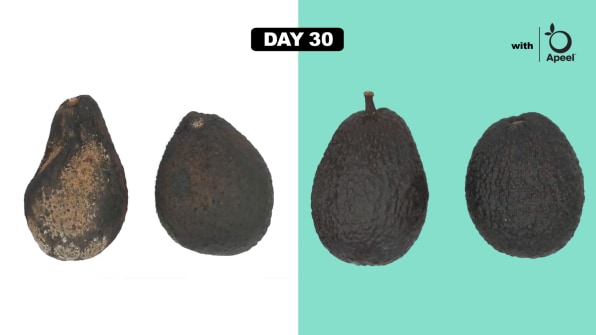Now avocado distributors know how long they have to ship their product, so it doesn’t go bad in transit.

When a shipment of avocados arrives at an importer in the Netherlands, each fruit goes down a conveyor belt and two things happen: First, a machine applies an invisible, edible coating to help the avocado last longer. Next, the machine uses hyperspectral imaging—the same tech used by NASA to look for life on Mars—to look inside the fruit without removing the peel.
“This technology gives us the ability to see things about fruits and vegetables that you just couldn’t see before with the naked eye,” says James Rogers, CEO of Apeel, the California-based company that makes the technology. The company, founded in 2012, first began working on food waste by developing its food-based coating to act like a second peel to protect food; it can make it last twice as long. (So far, the company has applied the coating to avocados, apples, limes, oranges, mandarins, lemons, and plastic-free cucumbers.) Today, Apeel announced that it has acquired ImpactVision, another startup, so that it could add imaging to its equipment.
That’s information that wasn’t simple to predict before, since a given avocado or cucumber won’t last for a set number of days. “How that avocado behaves after it’s been picked actually is a function of the weather,” he says. “It’s a function of the growing environment. It’s a function of how it was handled. You introduce all this additional variability into something that was already variable. And so being able to take a measurement of individual pieces of produce, and know exactly what’s going on with that piece of fruit or vegetable, adds a level of predictability and quality assurance to the supply chain which is not a staple of the food system today.”

The company is rolling the new feature out across all of its equipment, and some customers are already using it, such as Nature’s Pride, the largest avocado importer in Europe. “By integrating this technology into their facilities, we now give them the ability to look at the produce after it’s arrived, and then make determinations about what kind of ripening conditions that produce should experience before it goes on to their customers,” Rogers says. “And that’s allowed them to rethink the way that they do their operations today. So instead treating everything coming in the same way, and then culling out the waste as a result, [they can] bring the fruit in, measure it, figure out which produce is going to behave in what ways, and treat it…how it should be treated optimally.”
"fruit" - Google News
May 11, 2021 at 08:00PM
https://ift.tt/3eCP9tl
This tech can see inside fruit so we know exactly when it will be ripe - Fast Company
"fruit" - Google News
https://ift.tt/2pWUrc9
https://ift.tt/3aVawBg
Bagikan Berita Ini














0 Response to "This tech can see inside fruit so we know exactly when it will be ripe - Fast Company"
Post a Comment